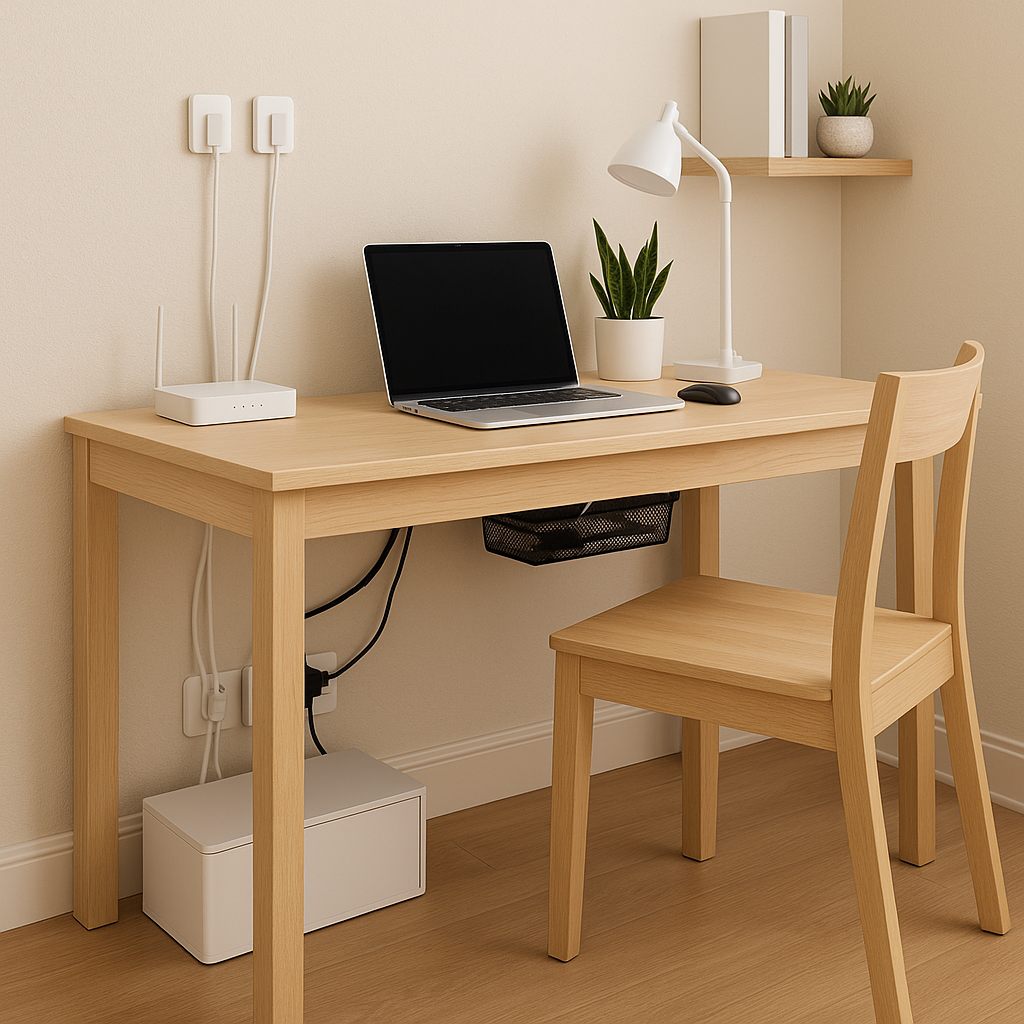A clean, organized home office boosts focus, reduces stress, and enhances your overall productivity. But even the most beautifully styled desk can be visually ruined by a tangle of cables, chargers, power strips, and devices. In small apartments where your workspace might be in plain sight, managing tech clutter is not just a luxury—it’s a necessity.
This article will guide you through practical and aesthetic strategies for hiding cables and equipment in your home office, helping you maintain a minimalist and distraction-free environment.
Why Cable Management Matters
Messy cables are more than just unattractive:
- They collect dust and are harder to clean around
- They can be a tripping hazard
- They interfere with your décor
- They can impact your focus by creating visual clutter
Good cable and equipment management keeps your workspace streamlined, professional-looking, and safe.
1. Start by Decluttering Unnecessary Devices
Before you even begin to hide things, assess what needs to stay:
- Do you use all your cords daily?
- Can any devices go wireless?
- Do you really need that second monitor or old printer?
Removing unused or duplicate equipment will make organizing the rest much easier.
2. Use a Cable Box to Conceal Power Strips
One of the easiest and most effective tools for cable management is a cable management box. These come in sleek designs and can be placed:
- Under your desk
- Beside your workstation
- On a shelf if you have limited floor space
They hide bulky power strips and excess cables while reducing dust collection and overheating risks.
DIY tip: Use a decorative storage box with cutouts for a budget version.
3. Mount a Power Strip Under the Desk
If your power strip is lying on the floor, it’s time to upgrade. Use adhesive strips, screws, or zip ties to mount it under your desk or along the back side.
Benefits:
- Keeps cords off the ground
- Prevents cable tangles
- Improves airflow and safety
Use removable adhesive strips if you’re renting.
4. Cable Sleeves or Tubes for Grouping Wires Cable sleeves are flexible tubes that bundle multiple cords into one neat line. You can route them:
- Behind your monitor and down to your power source
- Along a wall or the back of a desk
- Through a shelf unit to hide clutter
They come in neutral colors or fun prints to match your decor.
5. Desk Grommets for Built-In Cord Pass-Throughs If you’re customizing a desk or buying a new one, look for models with grommets—small plastic-lined holes that allow cords to pass through.
This helps keep your cables:
- Out of sight
- Organized
- Protected from tangling
DIY option: Drill a small hole in the desk and add a grommet insert, or use a clamp-on cable guide.
6. Use Under-Desk Trays or Baskets
Mount a metal or mesh tray under your desk to hold cords, chargers, power strips, or routers.
You can also use:
- Small plastic baskets
- Wire kitchen organizers
- Repurposed magazine holders
Just ensure that ventilation is adequate, especially if placing electronic items inside.
7. Cable Clips and Adhesive Guides
These small tools offer huge benefits. Use them to:
- Route cables along furniture edges
- Hold chargers in place on the desk surface
- Guide cords around corners cleanly
Look for reusable silicone or adhesive-backed plastic clips that can be placed along desk edges or walls.
8. Go Wireless Where Possible
Less cables = less clutter.
Consider switching to:
- Wireless keyboard and mouse
- Bluetooth speakers
- Wi-Fi printers
- Wireless charging pads
This won’t eliminate all cables, but reducing them cuts the visual chaos significantly.
9. Hide Modems, Routers, and Tech Hubs
These devices often sit in awkward, visible places. To conceal them:
- Place them in a decorative basket with cutouts
- Use a box with ventilation and a hinged lid
- Store inside a bookcase cabinet with cord access at the back
- Mount under a desk with Velcro straps
Make sure not to block ventilation or signal transmission.
10. Integrate Equipment into Your Decor
If you can’t fully hide it—make it beautiful.
Examples:
- Use coordinated tech colors (matte black, white, or warm neutrals)
- Paint or wrap cables with cord covers that match your walls
- Choose equipment with minimalist designs
- Use decorative items like books, plants, or vases to disguise devices
This is especially helpful for renters who can’t drill holes or modify furniture.
11. Label and Identify Your Cords
Tangled cords become a nightmare when you don’t know which one goes where. Use:
- Cord tags or labels
- Color-coded ties
- Washi tape with handwritten tags
Label both ends so you can quickly unplug the right one when needed.
12. Create a Charging Station
Gather phones, tablets, headphones, and power banks in one dedicated area.
Charging station ideas:
- A drawer with a power strip inside
- A desktop organizer with slots for each device
- A hidden box with cord openings
This keeps cables from spreading across your desk or floor.
13. Keep Your Setup Easy to Adjust
It’s tempting to fully hide every cable, but make sure they’re still accessible. You’ll eventually need to:
- Unplug a device
- Move your monitor
- Clean behind furniture
Leave just enough slack in your cords and keep cable paths easy to trace.
14. Don’t Forget the Floor Area
Use cable raceways to hide cords that run across the floor. These can:
- Prevent tripping hazards
- Protect cords from pets or vacuums
- Blend with your flooring
They come in paintable, adhesive, or snap-on versions for all floor types.
A clutter-free, cable-managed home office is more than just aesthetically pleasing—it’s a key step toward a more focused, comfortable, and professional workspace. With simple tools like trays, clips, sleeves, and boxes, even the smallest apartment can feel sleek and organized.
Whether you work full-time from home or just need a tidy corner for occasional tasks, hiding your cables and equipment helps create a calming environment where creativity and productivity can thrive.

